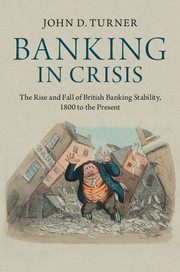Book contents
- Frontmatter
- Contents
- List of figures
- List of tables
- Acknowledgements
- 1 Introduction: Holding shareholders to account
- 2 Banking instability and risk shifting
- 3 The evolution of British banking structure and stability since 1800
- 4 Major and minor British banking crises since 1800
- 5 Banking stability, shareholder liability and bank capital
- 6 Averting or creating banking crises? The lender of last resort and bank rescues
- 7 Banking stability and bank regulation
- 8 Restoring banking stability: Policy and political economy
- Bibliography
- Index
8 - Restoring banking stability: Policy and political economy
Published online by Cambridge University Press: 05 July 2014
- Frontmatter
- Contents
- List of figures
- List of tables
- Acknowledgements
- 1 Introduction: Holding shareholders to account
- 2 Banking instability and risk shifting
- 3 The evolution of British banking structure and stability since 1800
- 4 Major and minor British banking crises since 1800
- 5 Banking stability, shareholder liability and bank capital
- 6 Averting or creating banking crises? The lender of last resort and bank rescues
- 7 Banking stability and bank regulation
- 8 Restoring banking stability: Policy and political economy
- Bibliography
- Index
Summary
Banks and governments have always had a symbiotic relationship.
Anat Admati and Martin HellwigHumpty Dumpty sat on a wall.
Humpty Dumpty had a great fall.
All the king’s horses and all the king’s men
Couldn’t put Humpty together again.
History and the Great Crash
From the long-run perspective developed in this book, it is relatively easy to understand why the 2007–8 crisis happened. Although popular opinion places the blame at the feet of reckless bankers and their huge bonuses, these are only symptoms of a much deeper problem. This book argues that bankers simply respond to the prevailing incentive structures – the culture of greed and excessive compensation were simply endogenous to the institutional setting.
The concept of risk shifting is endemic to banking and has had to be addressed by bankers, depositors and governments from earliest times. Until the interwar period, risk shifting in the United Kingdom was curtailed by the fact that bank shareholders had not only invested substantial amounts of capital in banks, they also were liable beyond what they had paid in through unlimited liability, reserve liability or uncalled capital. There was a substantial decline in this contingent capital, as well as paid-up capital relative to deposits or bank assets, during the interwar era and the 1940s. However, the low levels of capital and contingent capital that were reached in the 1950s did not concern the Bank of England, the Treasury or depositors. Why not? Quite simply, from 1939 onwards, the banking system was in lockdown due to financial-repression policies put in place to reduce the huge debt incurred fighting World War II.
- Type
- Chapter
- Information
- Banking in CrisisThe Rise and Fall of British Banking Stability, 1800 to the Present, pp. 204 - 220Publisher: Cambridge University PressPrint publication year: 2014

